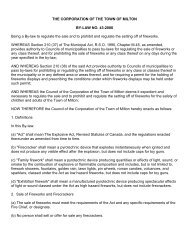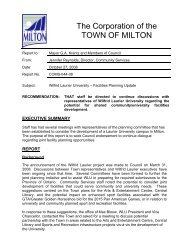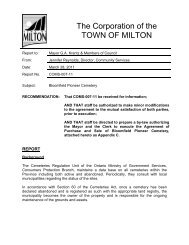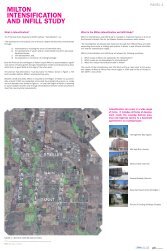Sierra Planning and Management Velodrome - Town of Milton
Sierra Planning and Management Velodrome - Town of Milton
Sierra Planning and Management Velodrome - Town of Milton
You also want an ePaper? Increase the reach of your titles
YUMPU automatically turns print PDFs into web optimized ePapers that Google loves.
<strong>Sierra</strong> <strong>Planning</strong> & <strong>Management</strong><br />
4<br />
4 <strong>Velodrome</strong> Business Plan – <strong>Town</strong> <strong>of</strong> <strong>Milton</strong><br />
Category 1 <strong>and</strong> 2 tracks must meet the following criteria (calculated for maximum safe speeds in the<br />
range 85 km/h up to 110 km/h):<br />
Business Plan | January 2012<br />
Exhibit 2: Criteria for UCI Track 1 <strong>and</strong> Track 2<br />
Length <strong>of</strong> Track 250 m 285.714 m 333.33 m 400 m<br />
Radius <strong>of</strong> bends 19-25 m 22-28 m 25-35 m 28-50 m<br />
Width 7-8 m 7-8 m 7-9 m 7-10 m<br />
Source: UCI Cycling Regulations<br />
The <strong>Milton</strong> <strong>Velodrome</strong> is anticipated to meet the criteria <strong>of</strong> a Category 1 track per the UCI regulations.<br />
1.4 CYCLING: NATIONAL AND PROVINCIAL TRENDS<br />
While Canadians are becoming more active, choices for physical activity have become more diversified.<br />
Cycling in Canada is a popular leisure activity as well as mode <strong>of</strong> transportation, with one in five<br />
Canadians participating. According to Statistics Canada’s 2005 Canadian Community Health Survey (the<br />
latest available report released in 2008), cycling is the fifth most popular physical activity in Canada.<br />
Approximately 460,000 Canadians participated in cycling activities, <strong>and</strong> <strong>of</strong> these, about 6.3% are<br />
considered to be active participants (differentiated <strong>and</strong> defined as those who partake in organized<br />
sporting events). Another indication <strong>of</strong> the popularity <strong>of</strong> the sport is the scale <strong>of</strong> bike ownership. The<br />
Bicycle Trade Association <strong>of</strong> Canada reported that approximately 357,591 new bicycles were purchased<br />
in 2010, with unit sales amounting to just over $250 million. This is a significant increase to the 300,000<br />
bicycles that were sold in Canada in the previous year.<br />
A very large proportion <strong>of</strong> cycling (for leisure <strong>and</strong> for commuting) is completely unstructured <strong>and</strong><br />
individual in nature. Local cycling clubs (with membership ties to Provincial associations) represent the<br />
first level <strong>of</strong> organization for the sport. These local clubs <strong>of</strong>fer programming in recreational cycling as<br />
well as venturing into the competitive realm locally. Provincial, National <strong>and</strong> International organizations<br />
are involved in structuring the high performance spectrum <strong>of</strong> cycling training <strong>and</strong> competition.<br />
While frequently referred to as a single sport, cycling has several sub-disciplines, which include:<br />
� Road<br />
� Mountain Biking<br />
� BMX<br />
� Cyclo-cross<br />
� Track<br />
� Paracycling<br />
Track cycling is relevant to all cyclists as a form <strong>of</strong> cross-training (similarly, track athletes cross-train via<br />
road cycling <strong>and</strong> participating in other cycling disciplines); particularly because <strong>of</strong> the opportunity it<br />
provides for all-season conditioning (assuming use <strong>of</strong> an indoor facility).












